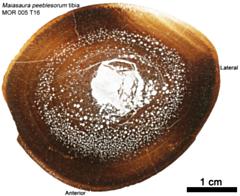Project 1139: H. N. Woodward, E. A. Freedman Fowler, J. O. Farlow, J. R. Horner. 2015. Maiasaura, a model organism for extinct vertebrate population biology: a large sample statistical assessment of growth dynamics and survivorship. Paleobiology. 41 (4):503-527.
Abstract
Fossil bone microanalyses reveal the ontogenetic histories of extinct tetrapods, but incomplete fossil records often result in small sample sets lacking statistical strength. In contrast, a histological sample of 50 tibiae of the hadrosaurid dinosaur Maiasaura peeblesorum allows predictions of annual growth and ecological interpretations based on more histologic data than any previous large sample study. Tibia length correlates well (R2>0.9) with diaphyseal circumference, cortical area, and bone wall thickness, thereby allowing longitudinal predictions of annual body size increases based on growth mark circumference measurements. With an avian level apposition rate of 86.4 μm/day, Maiasaura achieved over half of asymptotic tibia diaphyseal circumference within its first year. Mortality rate for the first year was 89.9% but a seven year period of peak performance followed, when survivorship (mean mortality rate=12.7%) was highest. During the third year of life, Maiasaura attained 36% (x=1260 kg) of asymptotic body mass, growth rate was decelerating (18.2 μm/day), cortical vascular orientation changed, and mortality rate briefly increased. These transitions may indicate onset of sexual maturity and corresponding reallocation of resources to reproduction. Skeletal maturity and senescence occurred after 8 years, at which point the mean mortality rate increased to 44.4%. Compared with Alligator, an extant relative, Maiasaura exhibits rapid cortical increase early in ontogeny, while Alligator cortical growth is much lower and protracted throughout ontogeny. Our life history synthesis of Maiasaura utilizes the largest histological sample size for any extinct tetrapod species thus far, demonstrating how large sample microanalyses strengthen paleobiological interpretations.Read the article »
Article DOI: 10.1017/pab.2015.19
Project DOI: 10.7934/P1139, http://dx.doi.org/10.7934/P1139
| This project contains |
|---|
Download Project SDD File |
Currently Viewing:
MorphoBank Project 1139
MorphoBank Project 1139
- Creation Date:
11 February 2014 - Publication Date:
01 October 2015 - Project views: 29188

- Media downloads: 23

This research
supported by
Authors' Institutions ![]()
- Indiana University-Purdue University At Indianapolis
- Montana State University
- Museum of the Rockies
Members
| member name | taxa |
specimens |
media | media notes |
| Holly Woodward Project Administrator | 1 | 3 | 8 | 8 |
Project has no matrices defined.
Project views 
| type | number of views | Individual items viewed (where applicable) |
| Total project views | 29188 | |
| Project overview | 3683 | |
| Media views | 11514 | Media search (4841 views); M326122 (752 views); M340007 (1040 views); M326119 (786 views); M326126 (785 views); M326125 (740 views); M340003 (761 views); M326124 (918 views); M326121 (891 views); |
| Documents list | 1738 | |
| Folio views | 2434 | Folio list (1183 views); MOR 005 T16 (567 views); MOR 005 T46 (684 views); |
| Specimen list | 4839 | |
| Taxon list | 2133 | |
| Bibliography | 1233 | |
| Views for media list | 1613 | |
| Matrix views | 1 | Matrix landing page (1 view); |
Project downloads 
| type | number of downloads | Individual items downloaded (where applicable) |
| Total downloads from project | 311 | |
| Project downloads | 287 | |
| Media downloads | 23 | M326124 (4 downloads); M326121 (6 downloads); M326119 (3 downloads); M340007 (5 downloads); M340003 (5 downloads); |
| Document downloads | 1 | Woodward et al. Supplementary Files (1 download); |

